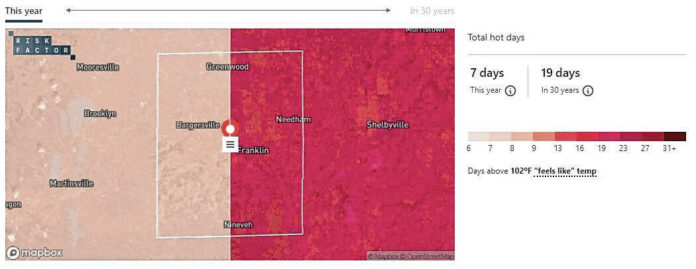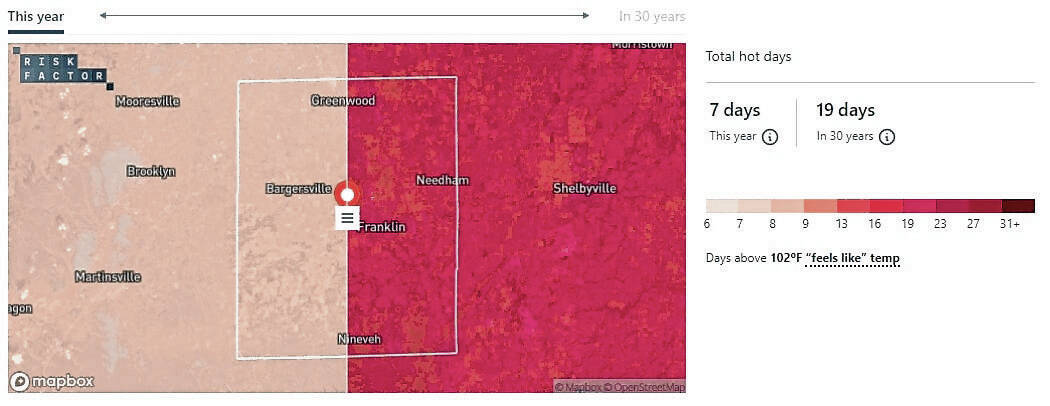Johnson County could find itself in a new “extreme heat belt” in 30 years if climate change continues on the current course, a new study says.
The First Street Foundation, a nonprofit research and technology group working to define the United States’ growing climate risk released its Sixth National Risk Assessment: Hazardous Heat on Aug. 15. The report identifies the impact of increasing temperatures down to a property level and how the frequency, duration and intensity of extremely hot days will change over the next 30 years from a changing climate, according to foundation officials.
Across the country, on average, the local hottest seven days are expected to become the hottest 18 days by 2053. In the case of extreme heat, the study found that more than 8.1 million people are expected to experience temperatures above 125°F in 2023 in the U.S., the highest level of the National Weather Services’ heat index. By 2053, three times that many people — 107 million — will experience that extremely dangerous heat, the study says.
Temperatures in some areas will increase more than in others, including in a new extreme heat belt, stretching from Texas north to Indiana and even parts of Wisconsin, the study found.
171% increase of extreme heat days
Among Indiana’s 92 counties, Johnson County ranks sixth for counties that are expected to see the greatest increase in local hot days, or days where the heat index, or “feels like,” is expected to be above 102 degrees. This year, the county is expected to see seven hot days, but in 30 years, the number will jump to 19 hot days a year, a 171.4% increase, according to the study.
Thirty years ago, in 1992, only three hot days were expected, according to data from Risk Factor, a website published by the First Street Foundation focusing on climate risk factors for properties.
The number of consecutive hot days is also expected to increase from one day this year to three days by 2052. In 1992, there were zero consecutive hot days in the county, data shows
The chances of a heat wave for Johnson County will also increase from 50% this year to 83% in 2052. The foundation defines heat waves as three or more consecutive days where the “feels like” temperature exceeds 102 degrees. In 1992, the chance of a heat wave was 19%, data shows.
There are several factors that can exacerbate the effects of extreme heat across an area. Researchers found in general that low-lying areas where humidity is high and expected to increase, and are located further away from large bodies of water, tend to be more susceptible to extreme heat events in the next 30 years, said Dr. Jeremy Porter, chief research officer for the First Street Foundation.
“In general, distance from water, and growing humidity, make an area more susceptible to increases in absolute and heat indexed temperatures,” Porter said.
Humidity is one of the primary factors that drive up heat indexes. When there is higher humidity or more moisture in the air, human bodies are not able to properly sweat to regulate their temperatures, which can cause short- and long-term harm, he said.
For a “feels like” temperature to reach 125 degrees, the atmospheric temperature only needs to hit about 95 degrees when the humidity is around 80%, he said.
Heat would tax infrastructure, utilities
Excessive heat can also affect infrastructure, sometimes having dangerous and devastating effects, Porter said. Cement, pavement and steel that reaches temperatures of more than 140 degrees could cause dangers to both the skin and paws of those walking on it.
The heat could cause bridge joints to swell, causing them to malfunction, and cause railway lines to become wavy. Wavy lines could cause train derailments. At airports, excessive heat can cause the tarmac to melt under the weight and stress of an airplane, he said.
The heat will also impact power grids, with energy use expected to increase over time as more people cool homes and buildings. The age of a building or home, along with the age and efficiency of its cooling systems, will determine how much additional energy is needed on excessively hot days, Porter said.
For Johnson County, the increase in energy consumption is expected to increase on an average of 10 days from now until 2052. Across the country this year, energy usage is expected to increase on 162 days, while in 2052, the number will rise to 172, causing an 18.6% increase in energy usage, data shows.
Indiana is among the top 20 states expected to see an increase in costs associated with increased air conditioning use, with the state expected to a nearly $70 million increase by 2053. Indiana is ranked 17th on the list, while California, which is expected to see a $574 million increase, is ranked first.
For the energy system, it’s not the prolonged exposure to heat that is a concern for areas, but the short bursts of exposure to extreme heat events over a 2- to 3-day period. These bursts can tax the system beyond its design specifications, he said.
Quality of life, crops in jeopardy
Excessive and extreme heat is one of the most dangerous climate hazards that can impact the health and well-being of Americans, Porter said. This includes quality of life.
Changes in local hot day temperatures across the U.S. mean that even if there were heat waves that only reached into the 80s in places such as the Pacific Northwest, they still are potentially dangerous because local populations are not used to those temperatures. At 100 degrees, people risk fatigue, dehydration, cramps and heat exhaustion, Porter said.
“At the most extreme end of the spectrum, potentially fatal complications such as heat stroke and death are also possible at heat indexed temperatures of 125 degrees Fahrenheit,” he said.
The extreme heat could also affect the stability of vegetation and crops in not only Johnson County but across the country.
Increases in air and sea temperatures are causing larger instability in the climate system, which in turn is causing more extreme events. These events include both extreme heat events and extreme cold events like what happened in Texas earlier this year, Porter said.
The changing environment is causing extremes on both ends of the spectrum, and is causing “dire consequences” for agriculture that has been developed and thrives in stable environments, he said.
“Without that stability, traditionally fertile areas are going to become infertile and traditional production zones are going to shift,” Porter said.
If people are interested in looking at the risk factor for their properties, they can go to riskfactor.com.
How to cope with heat
There are a variety of ways people can use to help mitigate the effects of extreme heat.
For homes, people can invest in updating their insulation and sealing windows to keep cold air indoors. Blocking direct sunlight from windows by using insulated or black-out curtains could also help, foundation officials said.
Communities also play a role in protecting residents from heat illnesses, and there are steps communities can take to help those most vulnerable and to protect infrastructure.
One of the steps that can be taken is to provide shade and vegetation in outdoor areas, along with removing and covering paved surfaces. Officials can also establish community cooling and hydration centers, and make air-conditioned buildings open to the public, according to the foundation.
Expanding capacity for energy and water systems, combined with keeping maintenance staff on call, can help protect energy and water systems. Implementing load restrictions and congestion reduction efforts can help protect infrastructure and reduce the heat caused by traffic, officials said.
BY THE NUMBERS
Here’s a look at how the heat risk for Johnson County has changed from 1992 to 2022, and how it is expected to change by 2052. All numbers are estimates.
Days at or above 90 degrees
These days are days where the “feels like” temperature exceeds 90 degrees. Spending time outside during this conditions can be physically hazardous, especially for high-risk individuals.
1992: 26 days
2022: 47 days
2052: 67 days
Days at or above 100 degrees
These days are considered dangerous days for people to be spending time outside.
1992: 3 days
2022: 10 days
2052: 23 days
Days at or above 102 degrees
These days are any days where the “feels like” temperature exceeds 102 degrees for Johnson County.
1992: 3 days
2022: 7 days
2052: 19 days
Source: Risk Factor/First Street Foundation










